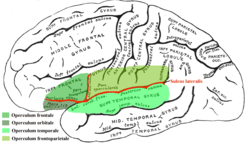岛盖
岛盖(英文:Operculum),可分为额叶岛盖、颞叶岛盖或顶叶岛盖,共同覆盖大脑皮层中的岛叶[1][2][3]。
| 岛盖 | |
|---|---|
 左侧大脑半球外侧面,岛盖位于绿色标记处 | |
 | |
| 标识字符 | |
| 拉丁文 | operculum frontale, operculum parietale, operculum temporale |
| 格雷氏 | p.825 |
| 《神经解剖学术语》 [在维基数据上编辑] | |
结构
编辑岛盖覆盖岛叶,后者是大脑皮层的一处内陷结构,埋藏在外侧沟深处[4]。其中,额顶叶岛盖(frontoparietal operculum)位于中央前回和中央后回上[1][5]。
功能
编辑额叶岛盖与思考、认知以及规划行为紧密相关[1][7]。颞叶岛盖包含颞横回,与听觉相关[1][8]。额顶叶岛盖与味觉品质、初级感觉以及运动功能相关[1][2][9]。
参见
编辑参考资料
编辑- ^ 1.0 1.1 1.2 1.3 1.4 Cheng, Jeffrey. Operculum. Radiopaedia. [2022-05-03]. (原始内容存档于2022-03-23) (美国英语).
- ^ 2.0 2.1 Frontal Operculum - an overview. ScienceDirect. [2022-05-03]. (原始内容存档于2022-05-03).
- ^ Parietal Operculum - an overview. ScienceDirect. [2022-05-03]. (原始内容存档于2022-05-03).
- ^ Lateral Sulcus - an overview. ScienceDirect. [2022-05-03]. (原始内容存档于2022-05-03).
- ^ Joseph M. Tonkonogy; Antonio E. Puente. Localization of Clinical Syndromes in Neuropsychology and Neuroscience. Springer Publishing Company. 23 January 2009: 392 [12 October 2012]. ISBN 978-0-8261-1967-4. (原始内容存档于2022-05-03).
- ^ Larroche JC. Development of the central nervous system. Developmental Pathology of the Neonate. Amsterdam: Excerpta Medica. 1977: 319–27. ISBN 978-90-219-2107-5., as cited in note 3 of Chen CY, Zimmerman RA, Faro S, et al. MR of the cerebral operculum: abnormal opercular formation in infants and children. American Journal of Neuroradiology. August 1996, 17 (7): 1303–11. PMID 8871716.
- ^ Higo, Takayasu; Mars, Rogier B.; Boorman, Erie D.; Buch, Ethan R.; Rushworth, Matthew F. S. Distributed and causal influence of frontal operculum in task control. Proceedings of the National Academy of Sciences. 2011-03-08, 108 (10): 4230–4235 [2022-05-03]. ISSN 0027-8424. PMC 3054014 . PMID 21368109. doi:10.1073/pnas.1013361108. (原始内容存档于2022-05-03) (英语).
- ^ Heschl's gyrus. Oxford Reference. [2022-05-03]. (原始内容存档于2022-05-03) (英语).
- ^ Horing, Björn; Sprenger, Christian; Büchel, Christian. The parietal operculum preferentially encodes heat pain and not salience. PLOS Biology. 2019-08-12, 17 (8): e3000205 [2022-06-22]. ISSN 1545-7885. PMC 6705876 . PMID 31404058. doi:10.1371/journal.pbio.3000205. (原始内容存档于2022-06-13) (英语).